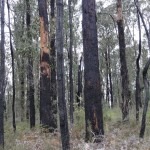 In February 2009, bushfires of unprecedented size and ferocity swept across regional Victoria. During the worst days of the firestorms, 173 people lost their lives and over 2,000 homes were destroyed. In all, more than 50 townships in remote rural and regional areas of Victoria were affected. Assistance of every kind came from across Australia as a nation sought to help those affected by the bushfires. Community leaders emerged who worked long and selflessly to assist in the rebuilding process. Neighbour helped neighbour, friendships were forged, acquaintances became connected and together the community started to recover. It was in this spirit of community renewal that the Community Based Gardening Project was conceived.
In February 2009, bushfires of unprecedented size and ferocity swept across regional Victoria. During the worst days of the firestorms, 173 people lost their lives and over 2,000 homes were destroyed. In all, more than 50 townships in remote rural and regional areas of Victoria were affected. Assistance of every kind came from across Australia as a nation sought to help those affected by the bushfires. Community leaders emerged who worked long and selflessly to assist in the rebuilding process. Neighbour helped neighbour, friendships were forged, acquaintances became connected and together the community started to recover. It was in this spirit of community renewal that the Community Based Gardening Project was conceived.
Helen Macpherson Smith Bushfire Grants Fund
In 2009, the Helen Macpherson Smith Trust established a $2 million HMS Bushfires Grants Fund. The purpose of the fund was to assist in the restoration of community life in rural townships damaged or destroyed by the 2009 Victorian bushfires. A $1 million grant allocation was made to Sustainable Gardening Australia for its proposal entitled, ‘Community Based Gardening in Bushfire Affected Areas’.
Community Based Gardening Project
This project commenced in July 2010, 16 months after the tragic 2009 bushfires and, in December 2013, was complete. It was designed to help communities to rebuild and regenerate through sustainable gardening activities. The project offered two options to bushfire affected communities.
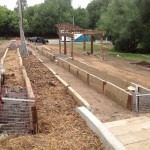 Option 1: Five bushfire affected communities were each assisted to create a community based garden that was to be accessible to all community members. As part of the funding package Sustainable Gardening Australia (SGA) employed local part time facilitators for the set up and establishment phase of each community garden. SGA, as project manager, worked closely with these local facilitators and their respective communities to ensure the garden met the needs of each and that they were set up using sustainable principles.
Option 1: Five bushfire affected communities were each assisted to create a community based garden that was to be accessible to all community members. As part of the funding package Sustainable Gardening Australia (SGA) employed local part time facilitators for the set up and establishment phase of each community garden. SGA, as project manager, worked closely with these local facilitators and their respective communities to ensure the garden met the needs of each and that they were set up using sustainable principles.
The five gardens that have been established under this project are;
- Beechworth Community Garden, corner Ford and Camp Streets, Beechworth
- Jindivick Community Garden, Kydd Parke Reserve, Jacksons Track, Jindivick
- Toolangi & Castella Community Garden, 1719 Healesville-Kinglake Road, Toolangi
- Yackandandah Community Garden, 3A William Street, Yackandandah
- Yinnar & District Community Garden, Main Street, Yinnar
It is intended that these five gardens will become a perpetual community asset, owned and managed by their communities for the benefit of the entire community.
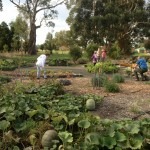 Option 2: Six bushfire affected communities were each given the opportunity to establish a smaller POD Community Food Space. POD is an acronym for productive, organic & diverse. Each POD set up six raised garden beds, built some composting bays and planted a mini-orchard at a local community space. Workshop participants were encouraged to connect with others with a view to developing new friendships as well as sharing gardening skills and experiences.
Option 2: Six bushfire affected communities were each given the opportunity to establish a smaller POD Community Food Space. POD is an acronym for productive, organic & diverse. Each POD set up six raised garden beds, built some composting bays and planted a mini-orchard at a local community space. Workshop participants were encouraged to connect with others with a view to developing new friendships as well as sharing gardening skills and experiences.
The six Victorian POD Community Food Spaces that have been established are:
- Callignee POD, Callignee Community Hall, Callignee
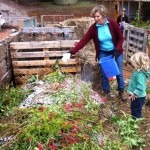
- Clonbinane POD, Clonbinane Community Hall, Linton Street, Clonbinane
- Dixons Creek POD, no fixed location but is run from members’ homes
- St Andrews POD, St Andrews Community Centre, 35 Caledonia Street, St Andrews
- Yarra Glen POD, Yarra Glen & District Living and Learning Centre, Anzac Ave, Yarra Glen
- Yea POD, front of the Yea Police Station, Hood St, Yea
Communally Run Gardens and Food Growing Spaces
Whilst community gardens are often setup with a system of individual plot holders, all of the gardens and PODs set up under this project have been set up as communally run areas. They are managed by the community for the benefit of the community. This reflects the differing needs of rural and regional communities where people have ample-sized gardens and may simply want to spend time gardening with others who share the same values and a love of growing food. Participants in these communally run gardens could be:

- Local kindergartens or primary schools who want to run outdoor gardening activities for terms 2 and 3, without the responsibility of managing the plots over summer.
- Local health services who want to run short courses on health and nutrition.
- Local apiarists who want to place their hives in the garden for their bees to forage.
- Local gardeners who want to meet and share skills and knowledge.
- Local sustainability groups who perhaps want to set up a seed savers’ network, food swap or farmers’ market.
- Local food banks who want to grow fresh food for their community kitchen and soup vans.
- Experimental gardeners who want to trial new ideas and unusual plant varieties.
It is possible for all of these activities to be accommodated in a communally run garden as long as they fit in with the intent and purpose of the garden. The governance and management structures need to be in place from the onset so that the basis upon which the garden is being run is clear and consistent and does not cause acrimony and confusion.
All of the communities who participated in this project were encouraged to develop a garden or food growing space that best reflected their community’s needs and their ability to manage it into the future. As a result each garden is unique and fits into the community that built it. All of the communities wanted to ensure that their gardens appealed to the non-gardeners as well as the gardeners. They wanted to include areas for communal gatherings and celebrations. Most importantly they wanted the gardens to be places of learning and experimentation.
Each of the communities is to be congratulated for achieving their goals and creating gardens that are sustainable, functional, communal, welcoming and strikingly beautiful.
Community Gardens Manual
An important outcome of this project is the creation of a Community Gardens Manual that will help other communities who are considering or have already started to build a community garden. This manual was launched by SGA in November 2013 and has quickly become one of the most downloaded items from our website. The manual is divided into 3 sections that cover the planning, building and establishing of a community garden. It is full of useful tips and information including links to other websites for further information. Whilst it has a Victoria focus, the manual can easily be adapted for use by other Australian community gardeners. If you haven’t already done so, check out the manual. And if you get a chance, why not make a trip to visit one of these gardens and be inspired by what can be achieved by communities working together to overcome a traumatic period in their lives.
‘In the shadow of the fire,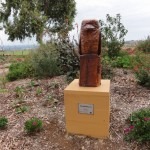
In the scar that remains,
In the wake of the aftermath,
I reflect.’
Catheryn Thompson, Yinnar & District Community Garden
Article and photos copyright to Elaine Shallue
Related Articles:
What to do for Flooded Gardens
What to do for flooded gardens is, unfortunately, a question more people need to ask. It seems that our climate is making extreme rainfall and…
Using Gardening for Therapy
Using gardening for therapy is the cornerstone of Kevin Heinze GROW (KHG), a social enterprise operating in the Doncaster and Coburg suburbs of…


